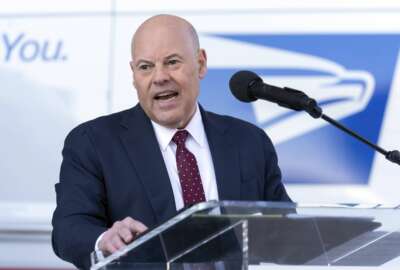USPS improves on GAO’s High Risk List, but ‘not there yet’ fixing long-term finances
The Government Accountability Office, in a recent report, recommended USPS can do more to ensure its 10-year reform plan succeeds — although the agency may need...
A congressional watchdog found the Postal Service’s initial steps to implement a 10-year reform plan and Congress passing major reform legislation last year are putting the agency closer to overcoming its long-term financial challenges.
But the Government Accountability Office, in a recent report, recommended USPS can do more to ensure its 10-year reform plan succeeds — although the agency may need more than its own self-help strategy to dig itself out from a financial hole.
David Marroni, GAO’s acting director of physical infrastructure issues, said in a recent interview that some potential USPS reforms are outside the agency’s control, and may require intervention from Congress.
“USPS’ business model is still not sustainable, in our view. It still has expenses that exceed its revenues,” Marroni said. “It still has large, unfunded debts and liabilities on its books. So while the strategic plan is a step to try and right the ship, it’s not there yet.”
USPS doesn’t expect to break even this year, as it previously expected in its 10-year reform plan. It did, however, cut projected losses for the decade by more than half — from $160 billion to $70 billion.
But as of the end of fiscal year 2022, USPS’s long-term unfunded liabilities and debt totaled about $144 billion, or about 184% of the agency’s revenue that year.
USPS recently reported a $549 million net loss for July 2023, and a nearly $5.8 billion net loss for fiscal 2023 so far. The agency projected about a $3.3 billion net loss for this point in the fiscal year.
USPS has increased its revenue by 0.4% — or $22 million — compared to the same point last year, despite the agency approving rate increases in July and January.
Marroni said USPS’s financial results for the third quarter of fiscal 2023 underscore the need for the agency — and Congress — to seriously consider GAO’s recommendations.
USPS has generally covered its expenses with its own revenue since 1970, but Marroni said lawmakers should consider whether this self-sustaining business model still works for the agency.
“I think it’s an open question, depending on the level of service that the nation wants from the Postal Service. Is that the right model? Or is some other model more appropriate?” he said.
First-class mail, USPS’ most profitable product, continues to see rapid declines. GAO also notes that USPS has been losing package volume to its competitors in recent years.
USPS is embarking on several major capital investments under its 10-year plan, but given its liabilities, GAO wrote that “USPS’ revenue might not be able to fully fund these investments”
The Postal Service Reform Act eliminated a 2006 requirement for USPS to pre-fund retiree health benefits well into the future, but the agency is still on the hook to pay its share of the premiums for its retiree health benefits.
The Office of Personnel Management estimates USPS will exhaust its Postal Service Retiree Health Benefits Fund in the early 2030s. At that point, USPS would need to pay for its share of retiree health premiums out of its own revenue — about $5 billion each year.
“That’s just one example of where those unfunded liabilities matter. But they really do still come into play, in terms of the Postal Service’s long-term financial condition,” Marroni said.
USPS’ long-term financial health has been on the GAO’s High Risk List since 2009. But Marroni said the agency’s implementation of its 10-year plan so far and Congress passing postal reform legislation last year represent steps in the right direction.
In its most recent High Risk List update in April, GAO gave USPS improved ratings on three of five criteria. USPS currently has either fully met or partially met all five criteria.
Any federal program or issue area needs to fully meet or substantially meet GAO’s recommendations across all five criteria before the watchdog removes it from the High Risk List.
Marroni said USPS’s improved standing on the High Risk List reflects the agency’s development and initial implementation of its strategic plan, as well as Congress’s passing the Postal Service Reform Act last year.
Marroni said USPS would need to prove it’s able to deal with its long-term liabilities.
“We would need to see sufficient improvement in their financial numbers in the trendline. What’s happening with their financial performance, and also that these underlying issues, these large unfunded liabilities and obligations, that there’s a plan for dealing with them, and that there’s progress being made to address those issues.”
While GAO found USPS is showing improvement under its 10-year plan, auditors recommend USPS modify the way it implements the strategy.
GAO found that USPS either fully or substantially met 6 of 11 leading practices, and either partially or minimally met five other leading practices.
As of August 2022, GAO found USPS was in the process of implementing 160 projects under the strategic plan, as part of the plan’s 13 strategic focus areas.
The watchdog agency is urging USPS to take additional steps to keep track of all these changes.
“USPS’s success at achieving the goals stated in its Strategic Plan will depend, in part, on how well the plan is implemented,” GAO wrote in its report.
Senior Director of USPS’s Office of Strategic Planning Luke Grossman told GAO that USPS generally agreed with GAO’s recommendations.
However, Grossman told auditors they didn’t acknowledge that there are many valid ways to approach strategic planning and project and that GAO’s critiques of its current cost and scheduling system for its strategic plan “represents a fundamental misunderstanding of our strategic planning process.”
GAO in its rebuttal wrote that its “leading practices are structured and presented in a way that allows different approaches to project management.”
“While we recognize the value USPS places on its iterative planning process and flexible approach, we maintain that there are risks to this approach that USPS could address through clearer implementation policies,” GAO wrote.
Among its most urgent recommendations, GAO suggests USPS track lessons learned throughout the 10-year plan, and develop a master integrated schedule for each project.
Marroni said USPS understanding lessons learned from completed projects is important, considering the agency still has more than 100 individual projects in the works.
“They do talk about, when projects are complete, what was learned. But they aren’t systematically identifying and disseminating these lessons across the full set of strategic planning projects,” he said. “And that’s important to do, because without those lessons, you’re missing out on opportunities to potentially better manage not only the one project in question, but the full set of projects going forward.”
GAO is also recommending USPS set up an integrated master schedule for all its projects under the 10-year plans. Marroni said the schedule would allow the agency to keep short-term initiatives — about 12-18 month sprints — and long-term initiatives, including its acquisition of a next-generation delivery vehicle fleet, running on schedule and on budget.
“When you’re starting this project through all these interim steps to completion, [it] can cause all kinds of issues — one of which can be slippage, delays — and the Postal Service can’t really afford that,” Marroni said.
GAO is also urging USPS to conduct root-cause analyses and identify the underlying causes of cost overruns and schedule delays when they happen.
“Some of that is happening. Our point is, there is no clear guidance on exactly when teams should do root cause analysis, and how to track the results of that analysis,” Marroni said.
Copyright © 2025 Federal News Network. All rights reserved. This website is not intended for users located within the European Economic Area.
Jory Heckman is a reporter at Federal News Network covering U.S. Postal Service, IRS, big data and technology issues.
Follow @jheckmanWFED






